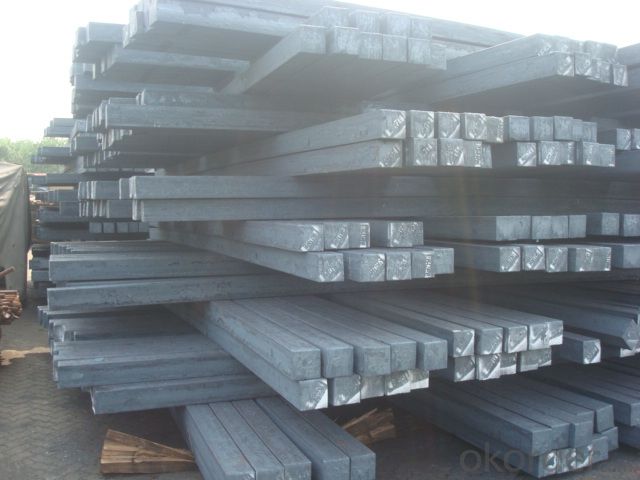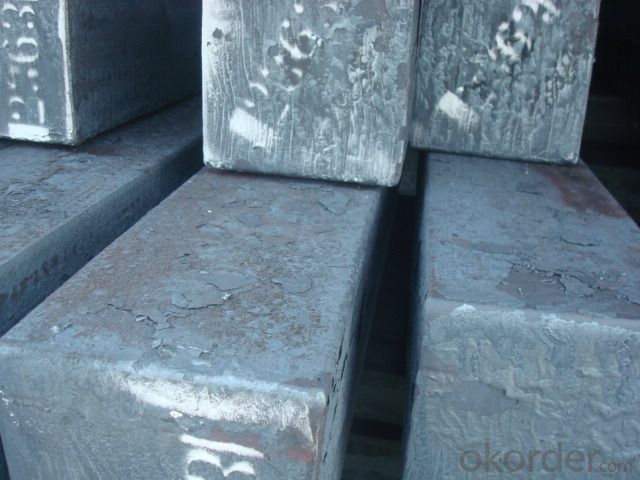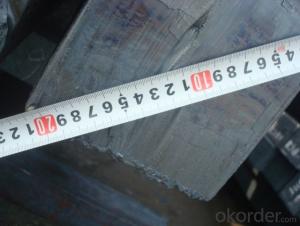Steel Bloom Manufactured by Big Blast Furnace
- Loading Port:
- Tianjin
- Payment Terms:
- TT OR LC
- Min Order Qty:
- 1000 m.t.
- Supply Capability:
- 100000 m.t./month
OKorder Service Pledge
OKorder Financial Service
You Might Also Like
Steel Bloom Manufactured by Big Blast Furnace
1.Structure of Steel Bloom Manufactured by Big Blast Furnace
Steel Bloom Manufactured by Big Blast Furnace is the raw material of all kinds of steel mill. Billet section of square, round, flat, rectangular and abnormity, etc Several, mainly related to shape of rolled products. Simple rolled section steel, choose cross section of square billet or rectangular billet. rolling The sector products such as flat steel, Angle steel, select the rectangular billet or slab. Had better profiled billet when production beams, channels, and in rolling process Lines and improve the yield. The raw material of round billet is the production of seamless tube.
2.Main Features of Steel Bloom Manufactured by Big Blast Furnace
Steel Bloom Manufactured by Big Blast Furnace section size should meet the requirements of rolling deformation and finished product quality, but also roll strength and biting condition of restrictions. General steel Billet section height H. And the roll diameter D The ratio of the ( namely H/D) Should be less than or equal to zero 0.5 . Length of steel billet by finishing temperature, Rolling time and the length of the product Or times ruler. When heated too long accident prone to bump the furnace wall of steel, too short, furnace bottom utilization rate is not high, influence the heating furnace production. For the production Choose a variety of steel and steel billet, should consider the affinities of billet, as far as possible in order to improve the productivity of the roughing mill, simplify the stock management of workshop.
3. Steel Bloom Manufactured by Big Blast Furnace Images


4. Steel Bloom Manufactured by Big Blast FurnaceSpecification
Steel Billet Manufactured by Blast Furnace rolled steel, after processing can be used for mechanical parts, forging parts, processing all kinds of steel, steel Q345B channel steel, wire rod is the role of the billet. Steel billet is used in the production of semi-finished products, generally cannot be used directly for the society. Steel billets and steel are strictly divided into standard, cannot decide to whether the business enterprise of the final product, and according to unified standards to perform the whole society. Typically, billet and the steel is relatively easy to distinguish, but for some steel billet, and have the same specification and same steel purposes (such as rolling tube billet), whether can be used for other industries, whether through steel processing process, whether through a finished product rolling mill processing to distinguish
Material standard The editor Range of thickness: 150-240 - mm + / - 5 mm width range: 880-1530 - mm + / - 20 mm Length: 3700-10000 - mm + / - 500 - mm Cross-sectional size: 64 * 64; 82 * 82; 98 * 98; 124 * 124; 120 * 150; 152 * 164; 152 * 170 mm Length: 9000 mm Section of tolerance: billet: 1.0 + / - 2.0-1.0 + / - 1.0 mm slab: width: + / - 2.0 mm thickness: + / - 3.0 mm The length tolerance: + / - 200 mm Section diagonal tolerance: 3.5-8.0 MM Billet section size protrusions requirements: < 1242 mm, do not allow; > = 1242 mm, < = 2 mm 1242 mm, < = 3 mm Beheading (shear) extension deformation: < 1242 mm billet: no control; The slab: < = 15 mm Surface tilt: no more than billet section 0.1 Bending: every 1 m length is not more than 10 mm The distortion: length < = 5 m, < = 11. ; The length of the < = 7.5 M, < = 5. Material % 3 sp/PS chemical composition: C Mn Si S P
5.FAQ of Steel Bloom Manufactured by Big Blast Furnace
①How about your company?
A world class manufacturer & supplier of castings forging in carbon steel and alloy steel,is one of the large-scale professional investment casting production bases in China,consisting of both casting foundry forging and machining factory. Annually more than 8000 tons Precision casting and forging parts are exported to markets in Europe,America and Japan. OEM casting and forging service available according to customer’s requirements.
②What is the advantage of the continue Casting steel Bloom comparing to the die casting steel Bloom?
Compared with die casting, continuous casting has the advantages of: 1. To simplify the Steel Bloom The production process 2. Improve the metal yield 3. Improve the quality of the Bloom 4. Reduces the steel worker's labor intensity 5. Save energy and reduce consumption
Steel Bloom is produced by the method of through three processes: It is through the steelmaking system of continuous casting equipment, directly by the molten steel pouring into Bloom; The second is the steelmaking system in the production of steel ingot casting Bloom through system of steel rolling rolling equipment or processing of steel semi-finished products; Three is the steelmaking system production of steel ingot by forging the semi-finished product processing equipment.
③How about the Q235 Grades?
Q235:A、B、C、D(GB700-88)
Q235A:C0.14~0.22% Mn0.30~0.65Si≤0.30S≤0.050P≤0.045
Q235B:C0.12~0.20% Mn0.30~0.670Si≤0.30S≤0.045P≤0.045
Q235C:C≤0.18% Mn0.35~0.80Si≤0.30S≤0.040P≤0.040
Q235D:C≤0.17% Mn0.35~0.80Si≤0.35S≤0.040P≤0.035
- Q:How do steel billets contribute to the manufacturing of aerospace components?
- Steel billets play a crucial role in the manufacturing of aerospace components. These billets are semi-finished products that are used as a starting material in the fabrication of various aerospace parts. One of the primary ways steel billets contribute to the manufacturing of aerospace components is through their versatility. Steel is known for its exceptional strength, durability, and resistance to corrosion, making it an ideal material for aerospace applications. Billets made from high-quality steel provide the necessary foundation for the production of components that can withstand the extreme conditions experienced during aerospace operations. Steel billets are often used in the production of critical aerospace parts such as engine components, landing gear, structural frames, and fasteners. The billets are first heated and then subjected to various forming and machining processes. These processes, such as forging, rolling, and extrusion, help shape the steel billets into the desired components, ensuring they meet the stringent requirements for strength, precision, and weight reduction demanded by the aerospace industry. Moreover, steel billets offer excellent design flexibility. They can be easily machined and shaped into complex geometries, allowing manufacturers to create intricate aerospace components with precise tolerances. This flexibility enables the production of lightweight yet strong parts, contributing to the overall weight reduction of aircraft and enhancing fuel efficiency. Furthermore, steel billets offer superior metallurgical properties. Through proper heat treatment and alloying techniques, the mechanical properties of the steel can be tailored to meet specific aerospace requirements. This allows manufacturers to achieve the desired balance between strength, stiffness, and toughness in the final components, ensuring they can withstand the high-stress environments encountered in aerospace applications. In conclusion, steel billets are an indispensable part of the manufacturing process for aerospace components. Their versatility, strength, design flexibility, and metallurgical properties make them an ideal starting material for the production of critical parts in the aerospace industry. By utilizing steel billets, manufacturers can ensure the production of high-quality, reliable, and durable components that meet the rigorous demands of the aerospace sector.
- Q:How are steel billets marked for identification and traceability?
- Various methods are utilized to mark steel billets for identification and traceability. One prevalent approach involves the utilization of unique identification numbers or codes. These numbers or codes can be engraved or stamped onto the billet's surface, enabling easy identification. Laser engraving machines or steel stamping tools are frequently employed for this purpose. Aside from identification numbers, other significant details, such as the grade, heat number, and production date, can also be marked on the billet. These details play a crucial role in traceability, allowing for the tracking of the steel's origin and quality. Moreover, some manufacturers may choose to employ additional marking techniques, such as paint or ink marking. This may entail the use of specific colors or symbols to represent different characteristics or attributes of the billet. For example, a particular color might indicate the intended use of the steel, while a symbol may signify the manufacturer's logo or quality certification. Overall, the marking of steel billets for identification and traceability is indispensable in ensuring quality control, verifying compliance with industry standards, and facilitating efficient inventory management throughout the supply chain.
- Q:What are the different testing methods used for steel billets?
- Some of the different testing methods used for steel billets include visual inspection, ultrasonic testing, magnetic particle testing, eddy current testing, and hardness testing.
- Q:How are steel billets transported internationally?
- Steel billets can be transported internationally through various means such as shipping containers, bulk carriers, or by rail and road transport. The choice of transportation method depends on factors like distance, cost, volume, and urgency of delivery.
- Q:What are the main challenges in steel billet production?
- There are several main challenges in steel billet production that manufacturers and producers face. One of the key challenges is ensuring consistent and uniform quality of the billets. Steel billets are the semi-finished products that are further processed into various steel products, and any inconsistency or variation in their quality can lead to defects or failures in the final products. Therefore, maintaining strict quality control measures throughout the production process is crucial. Another significant challenge is optimizing the production process to meet the desired quantity and quality targets while minimizing costs. This involves efficient utilization of resources such as raw materials, energy, and labor. Additionally, maintaining a balance between the production speed and quality can be challenging as increasing the speed may lead to reduced quality or increased defects. Ensuring the safety of workers and the environment is also a major challenge in steel billet production. The production process involves heavy machinery, high temperatures, and potentially hazardous materials, which can pose risks to the workers' health and safety. Implementing proper safety protocols, providing training, and ensuring compliance with regulatory standards are essential to address these challenges. Furthermore, meeting the ever-increasing demand for steel billets is a challenge for producers. The market demand fluctuates, and manufacturers need to be able to adjust their production capacity accordingly. This requires flexibility in production planning and efficient inventory management to avoid overproduction or stock shortages. Lastly, technological advancements and innovations in the steel industry pose both challenges and opportunities. Adopting new technologies, such as automation, artificial intelligence, and data analytics, can improve efficiency and productivity. However, incorporating these technologies into existing production processes can be complex and require significant investments and expertise. In summary, the main challenges in steel billet production include maintaining consistent quality, optimizing production processes, ensuring safety, meeting market demand, and adapting to technological advancements. Overcoming these challenges requires continuous improvement, innovation, and a proactive approach to stay competitive in the steel industry.
- Q:What is the role of steel billets in the manufacturing of tools and dies?
- Steel billets play a crucial role in the manufacturing of tools and dies as they serve as the raw material for shaping and forming these components. Billets are heated, forged, and machined to create the desired shape and strength required for tools and dies. The high-quality, durable nature of steel billets ensures that the resulting tools and dies possess the necessary hardness, toughness, and wear resistance to withstand the demanding conditions of their applications.
- Q:Reasons and treatment methods of billet stripping in continuous casting
- Uneven cooling causes stripping.Check that the water jacket is uneven;Then check the two cold, the nozzle is not even spray cooling water, jet angle position is correct.
- Q:How are steel billets used in the manufacturing of industrial tools?
- Steel billets are an essential raw material in the manufacturing of industrial tools. These billets, which are solid blocks of steel, serve as the foundation for creating various types of tools used in industries such as construction, automotive, and manufacturing. The first step in using steel billets for tool manufacturing is to heat them to a specific temperature. This process, known as forging, makes the steel more malleable and easier to work with. Once heated, the billets are then shaped and formed into the desired tool design using specialized machinery like power hammers and presses. The shaping process involves applying intense pressure to the heated billet, which transforms it into the desired tool shape. This can be a chisel, wrench, hammer head, or any other tool needed for specific industrial applications. The precise shaping ensures that the tool will have the necessary strength, durability, and functionality required for its intended use. After the initial shaping is complete, the tool is further refined and finished through processes like machining, grinding, and heat treatment. These additional steps help enhance the tool's performance and ensure its longevity. Machining removes any excess material and creates the necessary holes, threads, or other features required for the tool's functionality. Grinding provides a smooth surface finish and precise dimensions. Heat treatment is another critical process that involves subjecting the tool to controlled heating and cooling cycles. This treatment alters the steel's molecular structure, enhancing its hardness, strength, and toughness. Different heat treatment techniques like quenching and tempering are employed depending on the specific tool requirements. Once the tool has been shaped, machined, ground, and heat-treated, it undergoes a series of quality checks and inspections to ensure it meets the necessary specifications and standards. These checks include dimensional measurements, visual inspections, and functional tests to ensure that the tool is fit for its intended purpose. In summary, steel billets are integral to the manufacturing of industrial tools as they provide the base material that is shaped, machined, heat-treated, and refined to create durable and high-performing tools. The versatility and strength of steel make it an ideal choice for producing a wide range of tools used in various industries, contributing to their efficiency, productivity, and overall success.
- Q:Can steel billets be used for making decorative items?
- Yes, steel billets can be used for making decorative items. Steel billets can be shaped, molded, and crafted into various designs and forms to create decorative items such as sculptures, furniture, artwork, and architectural features. The strength and durability of steel make it suitable for these purposes while adding a modern and industrial aesthetic to the decorative pieces.
- Q:What are the different types of steel billet quality control tests?
- There are several types of steel billet quality control tests, including dimensional checks, chemical composition analysis, surface inspection, mechanical property testing, and non-destructive testing.
1. Manufacturer Overview |
|
|---|---|
| Location | |
| Year Established | |
| Annual Output Value | |
| Main Markets | |
| Company Certifications | |
2. Manufacturer Certificates |
|
|---|---|
| a) Certification Name | |
| Range | |
| Reference | |
| Validity Period | |
3. Manufacturer Capability |
|
|---|---|
| a)Trade Capacity | |
| Nearest Port | |
| Export Percentage | |
| No.of Employees in Trade Department | |
| Language Spoken: | |
| b)Factory Information | |
| Factory Size: | |
| No. of Production Lines | |
| Contract Manufacturing | |
| Product Price Range | |
Send your message to us
Steel Bloom Manufactured by Big Blast Furnace
- Loading Port:
- Tianjin
- Payment Terms:
- TT OR LC
- Min Order Qty:
- 1000 m.t.
- Supply Capability:
- 100000 m.t./month
OKorder Service Pledge
OKorder Financial Service
Similar products
New products
Hot products
Related keywords





























